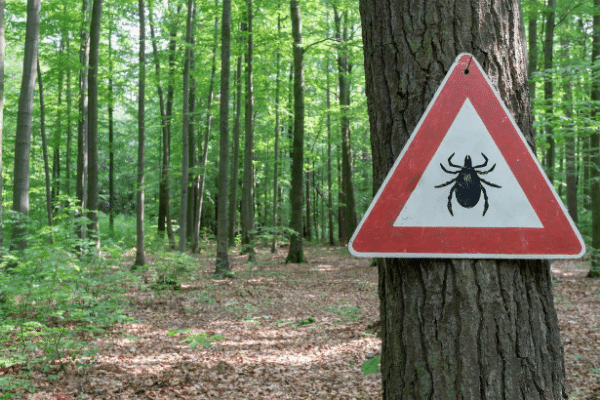Parks, beaches, garden centers, backyards, camp sites and other outdoor areas have become even more popular this summer as we practice social distancing. A recent survey by Civic Science found 40% more Americans who normally don’t find themselves outside enjoying nature, are eager to do so now due to cabin fever from the COVID-19 lockdowns.
Getting outside and enjoying the outdoors is good for you – but I want to ensure you are “Tick Aware.” Health experts have issued a special warning this summer to be on the lookout for ticks as a ferocious tick season is upon us now through mid-to-late October.
Tick Aware
Often mistaken as insects (which they’re not) – are actually classified as arachnids, or relatives of spiders, scorpions and mites. If you look closely at a tick when identifying it, it resembles a small spider with four pairs of legs and no antennae.
They require blood to fulfill their nutritional needs and use humans and animals/pets as a food source. Some species can transmit infectious bacterial diseases that are a threat to human health, like Lyme Disease.
Lyme Disease
The CDC reports Lyme disease as being the most common illness that is vector-borne or transmitted to humans by ticks.
- Lyme disease can be difficult to diagnose because symptoms, including the rash, are not consistent and may imitate other conditions
- Some symptoms are very similar to some COVID-19 symptoms, including fever, chills, headache, fatigue, and muscle aches.
- Lyme disease also weakens the immune system, which in turn can make a sufferer more vulnerable to contracting or having serious illness from the coronavirus
- About 80% of Lyme disease cases present with a tell-tale rash, shaped like a bull’s eye that appears 3-to-30 days after the tick bite — aiding in diagnosis
- It can affect tissues and organs, including Bell’s palsy (the loss of muscle tone on one or both sides of the face), neck pain that mimics meningitis, joint pain/swelling, shooting or pins-and-needles pain, and heart palpitations.
While most cases can be treated and eradicated with a few weeks of antibiotics, diagnosis and early treatment is important.
Prevention
Protect yourself, loved ones and pets by being tick aware, prepared, and watchful:
- Be vigilant– ticks are busiest in warmer months in grassy/wooded areas, in low hanging trees, under leaves, plants, ground covering, around walls, woodpiles or water areas – or on your outdoor pets. Remember too, ticks use a local anesthetic, so their bites can go undetected.
- Once returning indoors, conduct a full-body check including hard-to-see places such as the scalp, armpits, in and around the hair, behind the ears, knees, and the groin.
- Bathe/shower within 2 hours of coming indoors—it’s easier to find ticks and get them off
- Wear protective clothing, long-sleeve shirts, long pants and closed toed shoes with socks
- Use 20-30% DEET insect repellent on clothing and exposed skin, paying attention to feet, legs, and ankles
- Once inside, remove and wash clothes worn outside, setting the dryer on the highest temperature (which helps to kill ticks). Remember to check backpacks too.
- Pets are particularly at risk for ticks/fleas and bringing them into your home, car, and yard–make sure to check them and use preventative products against ticks (fleas).
- Consider using a professional pest company to help reduce insects around your property
Found an Embedded tick? – Don’t panic!
- If a tick is left on the body for an extended period of time, it will eventually embed itself into the skin and begin feeding. Embedded ticks should be removed promptly but carefully to avoid squeezing them. Squeezing can expel the contents of the tick into the wound, which greatly increases the chances of contracting a tick-borne disease.
- If you find a tick attached to your skin, don’t panic. The key is to remove it as soon as possible
- Use a plain set of fine-tipped tweezers.
- Grasp the tick as close to your skin’s surface as possible and pull outward with steady, even pressure.
- Don’t twist or jerk the tick, as it can cause the mouthparts to break off and remain in your skin.
- After removal, clean bite area and your hands with rubbing alcohol or soap/water.
- Never crush the tick with your fingers.
- Dispose of a live tick by putting it in alcohol, placing it in a sealed bag/container (for identification) or wrap/dispose in strong tape
- If you are concerned or develop a rash or fever within several weeks of removing a tick, see your doctor.
- Avoid folklore remedies such as “painting” the tick with nail polish or petroleum
It’s wonderful to go out and enjoy the great outdoors – just be tick aware!
Dr. Nina Radcliff is dedicated to her profession, her patients and her community, at large. She is passionate about sharing truths for healthy, balanced living as well as wise preventive health measures.
She completed medical school and residency training at UCLA and has served on the medical faculty at The University of Pennsylvania. She is a Board Certified Anesthesiologist. Author of more than 200 textbook chapters, research articles, medical opinions and reviews; she is often called upon by media to speak on medical, fitness, nutrition, and healthy lifestyle topics impacting our lives, today.
Dr. Nina Radcliff is dedicated to her profession, her patients and her community, at large. She is passionate about sharing truths for healthy, balanced living as well as wise preventive health measures.
She completed medical school and residency training at UCLA and has served on the medical faculty at The University of Pennsylvania. She is a Board Certified Anesthesiologist. Author of more than 200 textbook chapters, research articles, medical opinions and reviews; she is often called upon by media to speak on medical, fitness, nutrition, and healthy lifestyle topics impacting our lives, today.

































